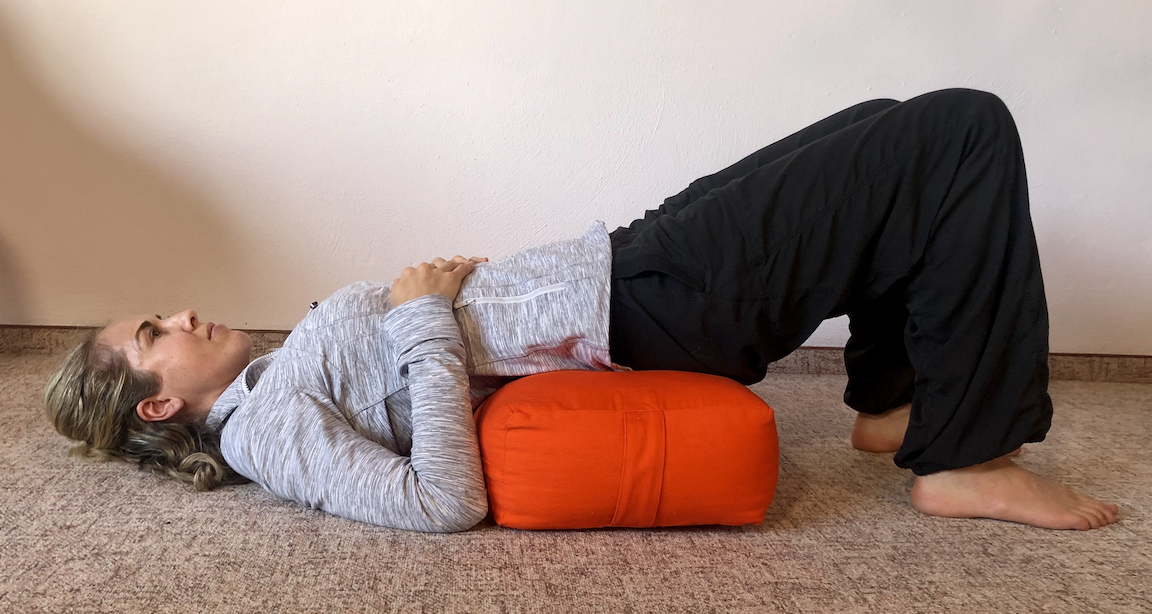Hysterectomy Preparation & Recovery

Recently, I received a fantastic question (see below):
"How can I prepare for a good recovery from a hysterectomy?"
First, let's define hysterectomy. A hysterectomy is the surgical removal of the uterus. Accompanying organs (including the fallopian tubes, ovaries, and/or cervix) may be removed at the same time... or they may not! It all depends on what your surgeon thinks is necessary. Talk to your doctor about KEEPING as much as you can intact.
Hysterectomies are often performed to treat conditions such as fibroids, heavy menstrual bleeding, endometriosis (when uterine-like tissue grows outside the uterus), adenomyosis (when endometrial tissue grows into the muscle wall of the uterus), uterine prolapse, and cancer.
Pelvic organ prolapse is one of the 3 most common reasons for hysterectomy.
But...
Hysterectomy should NOT be a "first line of defense" treatment for pelvic organ prolapse. Try conservative treatment methods (like pelvic floor physical therapy and/or my Lift program) first!
A hysterectomy removes organ(s) that provide pelvic organ support, hormone balance, and sexual pleasure. It's a fairly common/routine surgery, but it's still a significant medical procedure and should not be taken lightly! Except in the case of cancer, hysterectomies should be reserved for people who've tried conservative (non-surgical) treatment options, and they have not worked.
All that being said, if you had a hysterectomy before trying conservative treatment methods, YOU HAVE NOT FAILED. You are not less of a woman IN ANY WAY, and there's so much you can do to regain (and retain) your strength and PELVIC POWER.
Hysterectomy Prep & Recovery
In this article, we will explore the basics of hysterectomy, and how to prepare for the surgery. You can use the info about how to prepare as a part of your post-op recovery program, as well!!! Ask your surgeon when you can begin gentle core strengthening, and then utilize the info below in your rehabilitation program (along with seeing a pelvic floor specialist in person, if possible).
What happens during a hysterectomy:
There are three primary approaches for hysterectomy surgery: abdominal, vaginal, and laparoscopic. Although these approaches are very different, all three require an invasion of the tissues in the abdominal and pelvic regions. Specifically, the abdominal and laparoscopic approaches require incisions in the abdominal wall.
As with any surgery, there are risks involved. These risks include post-surgical infection, excessive bleeding, and/or complications associated with anesthesia. More specific to hysterectomy, post-surgical complications may also include urinary complaints, a possible decrease in sexual responsiveness if the cervix is removed, and an increased risk of prolapse due to a reduction in support structures (i.e. the uterus, fallopian tubes, and cervix).
Patients undergoing a hysterectomy will not be able to conceive after the surgery, and there may be hormonal changes that can force early menopause or require hormone replacement therapy.
The decision to have a hysterectomy is complex and often very emotional.
Please know that if you and your healthcare provider determine that a hysterectomy is the best treatment for your needs, you have not “failed,” you are not broken, and there is nothing to be ashamed of. Furthermore, there are multiple things you can do to prepare for a successful outcome!
How to Prepare for a Successful Hysterectomy*
*Note: this preparation info can be used in your post-op recovery, as well! Ask your surgeon when you can begin gentle core strengthening, and then utilize the info below (along with seeing a pelvic floor specialist in person).
STRENGTHEN
Strengthening the muscles before any type of surgery helps the muscles heal more quickly. "Pre-hab," or strengthening BEFORE surgery, improves the integrity of the tissues in/around the surgical site, and will give you the strength and awareness to work these muscles more quickly and effectively post-surgery. From a mind-body perspective, pre-hab also MENTALLY PREPARES you by allowing you to focus on the upcoming surgery positively; you can have peace of mind knowing that you are taking every step to prepare your body for optimal recovery.
There are three primary regions to focus on when it comes to pre-hab exercises for hysterectomy: The pelvic floor muscles, the gluteal (i.e. butt) muscles, and the deep abdominal muscles. Let's start with the pelvic floor. As noted above, there is an increased risk of prolapse post-hysterectomy, so one of the best things you can do is to start preparing your pelvic floor muscles NOW (before surgery) to optimally support your internal organs LATER (after surgery). You can do this via the exercises below and also via my Lift program, which includes essential lifestyle tips that will help you both before and after surgery.
Kegels for pre-hysterectomy strengthening
To make your kegel sessions successful, there are two key points to remember:
-
Squeeze and lift the muscles around your vagina and anus, and then fully and completely relax. (Be sure to relax fully after each contraction!!!). Complete 5-10 reps, working up to 5 second holds.
-
Remember WHY you're doing Kegels: to increase coordination and motor control of your pelvic floor muscles... not to make your vagina tighter!
Kegels can be done in any position, although supine (lying down on your back) is a great starter position since your pelvic floor muscles are not fighting gravity in this position. You can even place a pillow under your hips to use gravity to help assist you with your Kegels. As you get stronger, move to more upright positions such as seated or standing.

Focus on your Glutes (the Booty!)
You must balance your pelvic floor strengthening with gluteal (butt) strengthening. If you overdo kegels, the pelvic floor muscles can become short and tight and can pull your sacrum (the back of your pelvis) inward toward your pubic bone. Strengthening your glutes can help counteract this problem. Let me repeat: both pelvic floor AND gluteal strength (in balance) are needed for ideal pelvic health. For a safe and balanced bum-sculpting routine, try my “Hips Up Fitness” workout.
Try hips-up fitness for a strong booty!
Focus on your Deep Abdominals
Both the abdominal and laparoscopic approaches (for hysterectomy) create incisions in the abdominal wall. Wake up your abs NOW to heal more rapidly and easily later. The following is a great abdominal strengthener that works the deep abdominal muscles:
-
Lie on your back. Gently engage your pelvic floor (do a gentle Kegel contraction) and very gently draw your lower abdominal muscles (the muscles beneath your belly button) inward toward your spine. Your pelvic floor and low abs work together, as a team, so unite them now!
-
Bring one foot just a few inches off the floor, and then touch it back down. Repeat on the other side.
-
Keep your core strong and your lower back close to the ground as you alternate lifting one foot up, and then the other. Don’t let your pelvis rock side to side, and don't let your low back arch. The only thing that should be moving is your legs!
For more detailed instruction on this move, and additional exercises that strengthen your deep core, check out my “Beginner Core” workout:
MIND-BODY MEDICINE
Pranayama to Prepare for Hysterectomy
To manifest quick healing with the least amount of pain, the most important tool you can develop to prepare for a hysterectomy is conscious breathing (pranayama to the ancient yogis). Your breath is the most powerful instrument you have to optimize your physiological functioning.
Have you ever noticed that you don’t have to think to breathe but you can consciously control it if you want to? Breathing is regulated by your autonomic (automatic/involuntary) nervous system. It regulates your heart rate, respiratory rate, digestion, and elimination.
The autonomic nervous system is further broken down into the sympathetic aspect (fight or flight) and the parasympathetic aspect (rest and digest). These two systems are in constant interplay trying to create a state of best response and balance depending on what your body needs at the time. These systems affect your pain response, how quickly you heal, and how you deal with undesirable feelings.
Unfortunately, the autonomic nervous system doesn’t always behave like we’d like it to! Sometimes we feel stressed when we’d like to feel relaxed, and other times we feel lethargic and we’d like to feel brighter and more present. Your breath is the medicine that can cause powerful shifts in your energy (or prana in yogic language) to manifest the physiological state you’d like to create.
The breath can shift the autonomic nervous system in your favor, and facilitate great healing.
The optimal preparation for a life-changing surgery is a breathing practice that results in increased relaxation, decreased stress hormones in the bloodstream, and an intentional activation of the immune system. This facilitates calm, accelerated healing and is a tool that you will cherish before, during and after surgery.
Try this simple breathing practice that focuses on long, slow, repeated exhalations through your nose.
-
Let the nostril inhale be soft and smooth.
-
After each inhale try to gently lengthen the exhale until you achieve a 6-8 second outflow.
-
As you exhale focus on the directional flow of your breath starting in the low belly, traveling up and outward past the diaphragm, through the rib cage, and out the nose. The breath should always be relaxed and never forced.
-
To increase the relaxation effect, hold the breath out after exhale (retention) for 1-2 seconds.
Practice this pranayama for a week before surgery once a day (especially if you’re feeling nervous or discontent about the upcoming procedure) to prepare your breath and your body for the surgery. Take the gift of the breath with you and practice in the hospital, in recovery, and at home as you heal. This conscious breathing technique will help you to achieve strength without stress, trust in your healing capabilities, and pain reduction for optimal healing inside and out.
Meditation to Prepare for Hysterectomy
In addition to the breathing exercise described above, this 12-minute guided pelvic floor meditation will help you prepare for pelvic surgery by elevating your mindset, creating positive beliefs, and improving your mind-body connection.
LIFESTYLE MEDICINE
In addition to physical preparation via fitness, and mind-body preparation via relaxation and pranayama, there are other things you can consider including posture, ergonomics, nutrition, bowel habits, and more. All of these factors are discussed in the following interview with Michelle Lyons:
These tips are also covered in my Lift program, which is designed for prolapse relief, and is also EXCELLENT for anyone preparing for — or recovering from — hysterectomy.
CALM AND CONFIDENCE
I hope this post gives you hope and a PLAN so that you can feel calm and confident going into your surgery! Don’t forget to contact a women’s health physical therapist in your area for diagnosis and treatment specific to your needs.
*NOTE: This website in general, and this article specifically, is for general information and educational purposes only. It is not intended to diagnose or treat any medical condition, but rather to understand what options are available. Please seek the advice of a physician to properly diagnose your symptoms.
You might also like:
- My Lift program for hysterectomy pre-hab and rehab!
Does your pelvic floor need help?
Many women think they just need live with the changes they’re experiencing
“down there,” but this is NOT the case. Take the short quiz to find out if you have issues that can be solved naturally.








